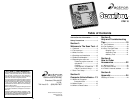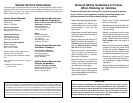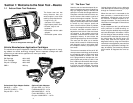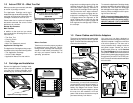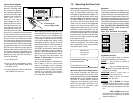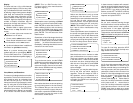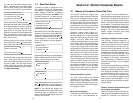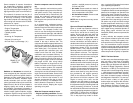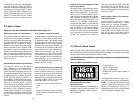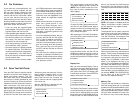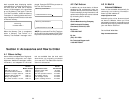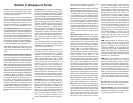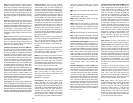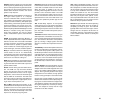24
Section 5: Glossary of Terms
Closed Loop (C/L): This is when a control system
performs an action (expecting a certain result),
then checks the results and corrects its actions
(if necessary) until the desired results are achieved.
Example: Fuel delivery. The PCM operates a fuel
injector in a way that should deliver an optimum
air/fuel mixture, as long as everything in the fuel
system is operating as expected. In closed loop
operation, the PCM uses the oxygen sensor to
check the results (fuel delivery may be different
than expected because of variations in fuel
pressure or injector operation). If the oxygen
sensor indicates a “rich” condition, the PCM will
compensate by reducing fuel delivery until the
oxygen sensor signals an optimum air/fuel mix-
ture. Likewise, the PCM will compensate for a
“lean” condition by adding fuel until the oxygen
sensor once again signals an optimum air/fuel
mixture.
Thus, closed loop operation means the PCM can
“fine tune” control of a system to achieve an exact
result providing the PCM has a means to check
results (like an oxygen sensor).
Data Link Connector (DLC): The Data Link
Connector (DLC) is a universal term for the
interface port between the vehicle’s on-board
computer and the ScanTool. It is sometimes
referred to as the Assembly Line Diagnostic Link
(ALDL), Vehicle Interface Port (VIP), or Serial
Communication Interface (SCI). The DLC is able
to transmit PCM data to the ScanTool as it is
processed. The DLC may be located in the
engine compartment or in the passenger com-
partment, depending on manufacturer. DLC de-
sign also varies from manufacturer to manufac-
turer, ranging from a 6-pin to a 17-pin connector
interface. All vehicles with OBD-II use a 16-pin
connector located in the passenger compart-
ment. The ScanTool requires manufacturer-spe-
cific adapter cables to link with non-OBD-II DLCs.
Data Stream: This is the actual data communica-
tions broadcast from the vehicle’s PCM to the
diagnostic connector. The individual manufac-
turers determine the number of “data bytes” a
specific engine will broadcast. The size of the
data stream is usually dependent on the com-
plexity of the engine, transmission, ABS, and
other systems supported by the PCM. All manu-
facturers supply program documents for each
year, engine, and option combination that a
particular PCM supports in all the manufacturer’s
Actuator: Devices that are powered by the PCM
to control things. Actuator types include relays,
solenoids, and motors. Actuators allow the PCM
to control engine operation.
A/F: Air/Fuel ratio. This refers to the proportion of
air and fuel delivered to the cylinder for combus-
tion. For example, if you have 14 times more air
than fuel (by weight) then the A/F ratio is 14:1
(read as “fourteen to one”). The ideal operating
A/F ratio in an automotive application is 14.7:1.
Check Engine Light (CEL): The “Check Engine”
light (CEL) will illuminate when the PCM detects
a circuit malfunction in any of the engine feed-
back circuits. When the malfunction occurs, the
CEL will remain lit as long as the PCM detects the
circuit problem. This will automatically set and
store a trouble code in the PCM’s memory. Some
manufacturers also refer to the CEL as a Malfunc-
tion Indicator Light (MIL), or the Emissions Main-
tenance Lamp (EMR) on some Chrysler trucks.
C3 or CCC: Computer Command Control. The
name of the General Motors electronic engine
control system used on most vehicles built since
1982.,
Chrysler Serial Communication Interface (SCI):
This is Chrysler’s vehicle adapter (or Data Link
Connector) used to link scan tools with the PCM.
Early Chrysler OBD systems (1981-83) broadcast
trouble codes, but gave no operating parameter
data. In 1983, the second phase of Chrysler
OBD, called the Serial Communication Interface
(SCI), was introduced with expanded serial data
and many test modes for the technician to access
with a scan tool. SCI provides the following
modes to access vehicle data: Diagnostic Test
Mode, Circuit Actuation Test Mode (ATM), Switch
Test Mode, Sensor Test Mode, and Engine
Running Test Mode. Each of these modes allow
for different procedures of diagnostic tests and
test routines. These routines are programmed
into the Chrysler Logic Module (LM) which then
passes the information on to the power module
or Single Board Engine Controller (SBEC). The
vehicle diagnostic adapter is located in the en-
gine compartment on the right-hand side, next to
the SBEC unit with a dust cap marked “Diagnos-
tic.”
25
vehicles. This information is used to design and
build aftermarket diagnostic equipment.
Detonation: Uncontrolled ignition of the air/fuel
mixture in the cylinder. Also referred to as “knock,”
detonation indicates extreme cylinder pressures
or “hotspots” which are causing the air/fuel mix-
ture to detonate early. High cylinder pressures
may be caused by excessive load (trailer towing,
A/C operation, etc.) or by too much spark ad-
vance. High octane fuel has a higher resistance
to uncontrolled ignition, and may be used to
control detonation when the PCM is unable to
retard timing sufficiently to prevent it from occur-
ring. NOTE: High octane fuel is not a cure for the
problem, only the symptom. If your vehicle expe-
riences long-term detonation, check for other
causes.
Diagnostic Trouble Codes: Diagnostic Trouble
Codes (DTC) indicate a malfunction flagged by
the PCM. The PCM will display a corresponding
numerical code number based on a look-up table
in the program of the on-board computer. De-
pending on the manufacturer, the number of
DTCs vary by vehicle and supported systems.
Most systems have the ability to store codes in
memory, which are commonly referred to as
“history codes” or “soft codes.” Malfunctioning
circuits will generate continuous Check Engine
lamp illumination, called “current codes” or “hard
codes.” History codes, based on the
manufacturer’s diagnostic strategy, will be cleared
from the PCM’s memory after several ignition
circuit start cycles if the circuit does not reflect the
failure again. This capability does allow the
technician to access some information on which
circuits were malfunctioning at a previous point.
OBD-II systems will transmit many more DTCs
than the past systems, and therefore will allow a
technician the ability to better pin-point failures
and past events. They only way to clear codes on
OBD-II systems will be with a scan tool that has
the proper programming to perform the function.
DIS: Distributorless Ignition System or Direct
Ignition System. A system that produces the
ignition spark without the use of a distributor.
Duty Cycle: A term applied to frequency signals
— those which are constantly switching between
a small voltage value (close to zero) and a larger
value (usually 5 volts or more). Duty cycle is the
percentage of time the signal has a large voltage
value. For example, if the signal is “high” (large
voltage) half of the time, the duty cycle is 50%.
If the signal is “high” only one fourth of the time,
then the duty cycle is 25%. A duty cycle of 0%
means the signal is always at a “low” value and
not changing. A duty cycle of 100% means the
signal is always at a “high” value and not chang-
ing. The PCM uses duty cycle type signals when
it wants more than just “on-off” control of an
actuator. This is how it works: A 50% duty cycle
signal going to a vacuum switching solenoid
means the solenoid will be “on” (passing full
vacuum) half the time, and “off” (passing no
vacuum) half the time. The average amount of
vacuum passing through the solenoid will be one
half the full value because the solenoid is only
“on” for half the time. This signal changes at a
rapid rate, as often as ten times per second. Thus
the PCM can get a vacuum controlled actuator to
move halfway between “no vacuum” and “full
vacuum.” Other positions can be achieved by
changing the duty cycle of the control signal
which in turn changes the average amount of
control vacuum.
DVM: Digital Volt Meter. An instrument using a
numeric readout to display measured voltage
values as opposed to a moving needle on a
gauge face. Usually the instrument has other
measuring capabilities, such as resistance and
current, and may be called a Digital Multi-Meter
(DMM). Most DVMs have 10 Megaohm input
impedance. This means the circuit under test will
not be electronically disturbed when the DVM is
connected for a measurement.
ECM: Electronic Control Module. The “brains” of
the engine control system. It is a computer
housed in a metal box with a number of sensors
and actuators connected with a wiring harness.
Its job is to control fuel delivery, idle speed, spark
advance timing, and emission systems. The PCM
receives information from sensors, then ener-
gizes various actuators to control the engine. The
ECM is frequently called the PCM (Powertrain
Control Module) in vehicles having other computers.
These other computers are used for climate
control, entertainment systems, transmissions,
etc.
EFI: Electronic Fuel Injection. A term applied to
any system where a computer controls fuel deliv-
ery to the engine by using fuel injectors.
Engine Parameters: This is the translated infor-
mation that is displayed on the scan tool screen.
Parameters will include the information inputs
and the output signals from the PCM.



